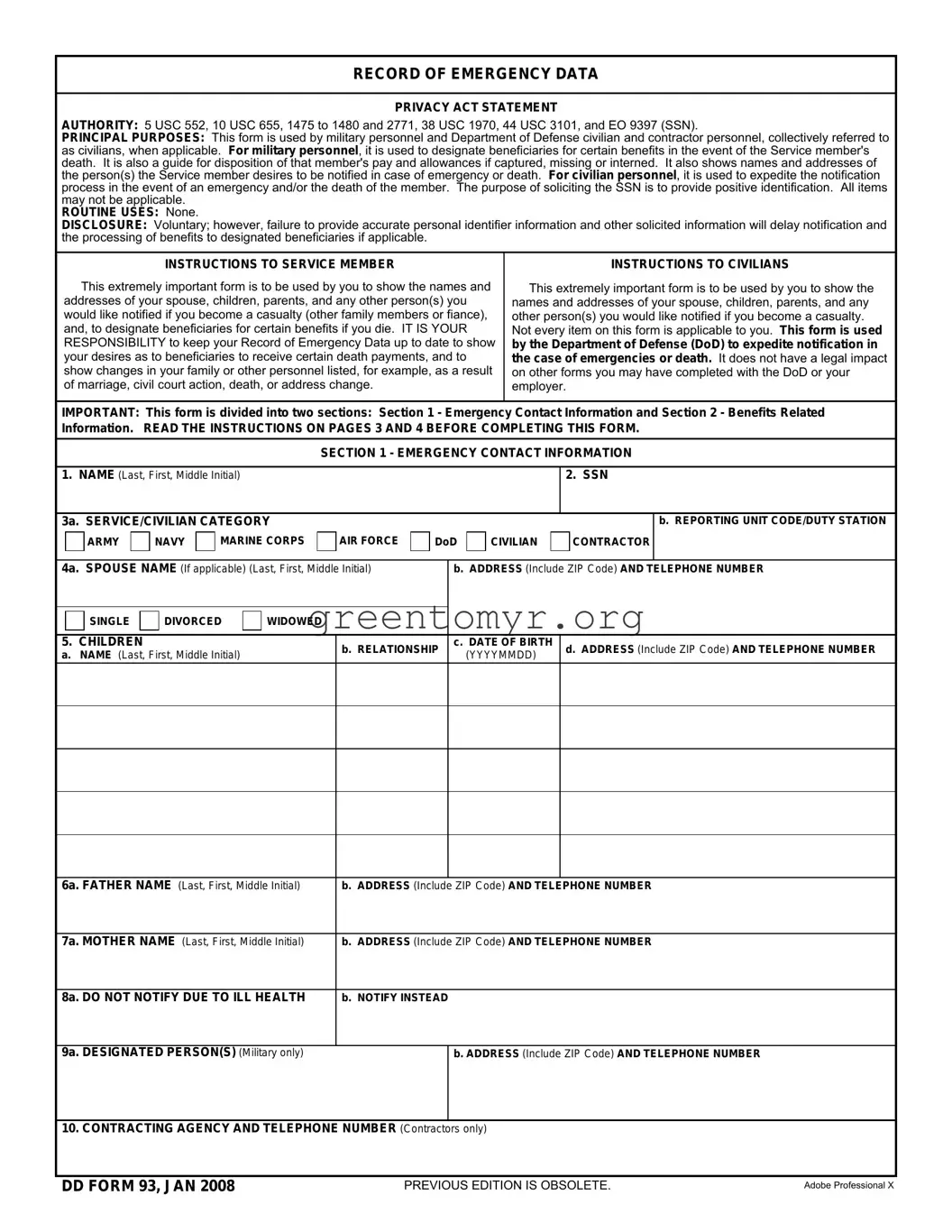All entries explained below are for electronic or typewriter completion, except those specifically noted. If a computer or typewriter is not available, print in black or blue-black ink insuring a legible image on all copies. Include "Jr.," "Sr.," "III" or similar designation for each name, if applicable. When an address is entered, include the appropriate ZIP Code. If the member cannot provide a current address, indicate "unknown" in the appropriate item. Addresses shown as P.O. Box Numbers or RFD numbers should indicate in Item 14, "Continuations/Remarks", a street address or general guidance to reach the place of residence. In addition, the notation "See Item 14" should be included in the item pertaining to the particular next of kin or when the space for a particular item is insufficient. If the address for the person in the item has been shown in a preceding item, it is unnecessary to repeat the address; however, the name must be entered. Those items that are considered not applicable to civilians will be left blank.
ITEM 1. Enter full last name, first name, and middle initial.
ITEM 2. Enter social security number (SSN).
ITEM 3a. Service. Military: Mark X in appropriate block.
Civilian: Mark two blocks as appropriate. Examples: an Army civilian would mark Army and either Civilian or Contractor; a DoD civilian, without affiliation to one of the Military Services, would mark DoD and then either Civilian or Contractor as appropriate.
ITEM 3b. Reporting Unit Code/Duty Station. See Service Directives.
ITEM 4a. Spouse Name. Enter last name (if different from Item 1), first name and middle initial on the line provided. If single, divorced, or widowed, mark appropriate block.
ITEM 4b. Address and Telephone Number. Enter the "actual" address and telephone number, not the mailing address. Include civilian title or military rank and service if applicable. If one of the blocks in 4a is marked, leave blank.
ITEM 5a-d. Children. Enter last name (only if different from Item 1) first name and middle initial, relationship, and date of birth of all children. If none, so state. Include illegitimate children if acknowledged by member or paternity/maternity has been judicially decreed. Relationship examples: son, daughter, stepson or daughter, adopted son or daughter or ward. Date of birth example: 19950704. For children not living with the member's current spouse, include address and name and relationship of person with whom residing in item 5d.
ITEM 6a. Father Name. Last name, first name and middle initial.
ITEM 6b. Address and Telephone Number of Father. If unknown or deceased, so state. Include civilian title or military rank and service if applicable. If other than natural father is listed, indicate relationship.
ITEM 7a. Mother Name. Last name, first name and middle initial.
ITEM 7b. Address and Telephone Number of Mother. If unknown or deceased, so state. Include civilian title or military rank and service if applicable. If other than natural mother is listed, indicate relationship.
ITEM 8. Persons Not to be Notified Due to Ill Health.
a.List relationship, e.g., "Mother," of person(s) listed in Items 4, 5, 6, or 7 who are not to be notified of a casualty due to ill health. If more than one child, specify, e.g., "daughter Susan." Otherwise, enter "None".
b.List relationship, e.g., "Father" or name and address of person(s) to be notified in lieu of person(s) listed in item 8a. If "None" is entered in Item 8a, leave blank.
ITEM 9a. This item will be used to record the name of the person or persons, if any, other than the member's primary next of kin or immediate family, to whom information on the whereabouts and status of the member shall be provided if the member is placed in a missing status. Reference 10 USC, Section 655. NOT APPLICABLE to civilians.
ITEM 9b. Address and telephone number of Designated Person(s). NOT APPLICABLE to civilians.
ITEM 10. Contracting Agency and Telephone Number
(Contractors only). NOT APPLICABLE to military personnel. Civilian contractors will provide the name of their contracting agency and its telephone number. Example: XYZ Electric, (703) 555-5689. The telephone number should be to the company or corporation's personnel or human resources office.
ITEM 11a. Beneficiary(ies) for Death Gratuity (Military only). Enter first name(s), middle initial, and last name(s) of the person(s) to receive death gratuity pay. A member may designate one or more persons to receive all or a portion of the death gratuity pay. The designation of a person to receive a portion of the amount shall indicate the percentage of the amount, to be specified only in 10 percent increments, that the person may receive. If the member does not wish to designate a beneficiary for the payment of death gratuity, enter "None," or if the full amount is not designated, the payment or balance will be paid as follows:
(1)To the surviving spouse of the person, if any;
(2)To any surviving children of the person and the descendants of any deceased children by representation;
(3)To the surviving parents or the survivor of them;
(4)To the duly appointed executor or administrator of the estate of the person;
(5)If there are none of the above, to other next of kin of the person entitled under the laws of domicile of the person at the time of the person's death.
The member should make specific designations, as it expedites payment.




